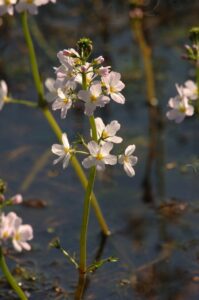Home / Rewilding / Wildlife Successes / Plants
Plants
Restoration of our water meadows and natural water courses has encouraged declining plants such as marsh speedwell, water violet and lesser water-parsnip – a species which seems to be in decline in Sussex as a whole. Other plants that have established include flowering rush and great yellow cress.
The resurgence of orchids – such as southern marsh, early purple and common spotted orchids - in our former arable fields is a strong indication of recovering soils, given that they depend on mycorrhizal fungi for germination. Bird’s nest and greater butterfly orchids have also been found in Great Cockshill Wood in the Northern Block.
Arable weeds thrive in the pig rootled areas, with species such as bird’s-foot trefoil, scarlet pimpernel, grass vetchling, centaury, lesser stitchwort and selfheal providing nectar and seed sources to a variety of animals. Field woundwort, and sharp-leaved and round-leaved fluellen are attractive archaeophytes that have established in our stockman’s vehicle tracks.
131 bryophytes – mosses, hornworts and liverworts – have been identified at Knepp, including several rarities, suggesting we may be one of the richest sites in Sussex for this group of non-vascular land plants. An abundance of the unusual floating liverwort Ricciocarpus natans, commonly known as fringed heartwort, was discovered in Knepp Mill Pond, along with floating crystalwort (Riccia fluitans). Another Sussex rarity discovered at Knepp is matted feather-moss (Sciuro-hypnum populeum), and an old ‘rewilded’ building roof has turned up interesting moss, Hedwigia ciliata.
